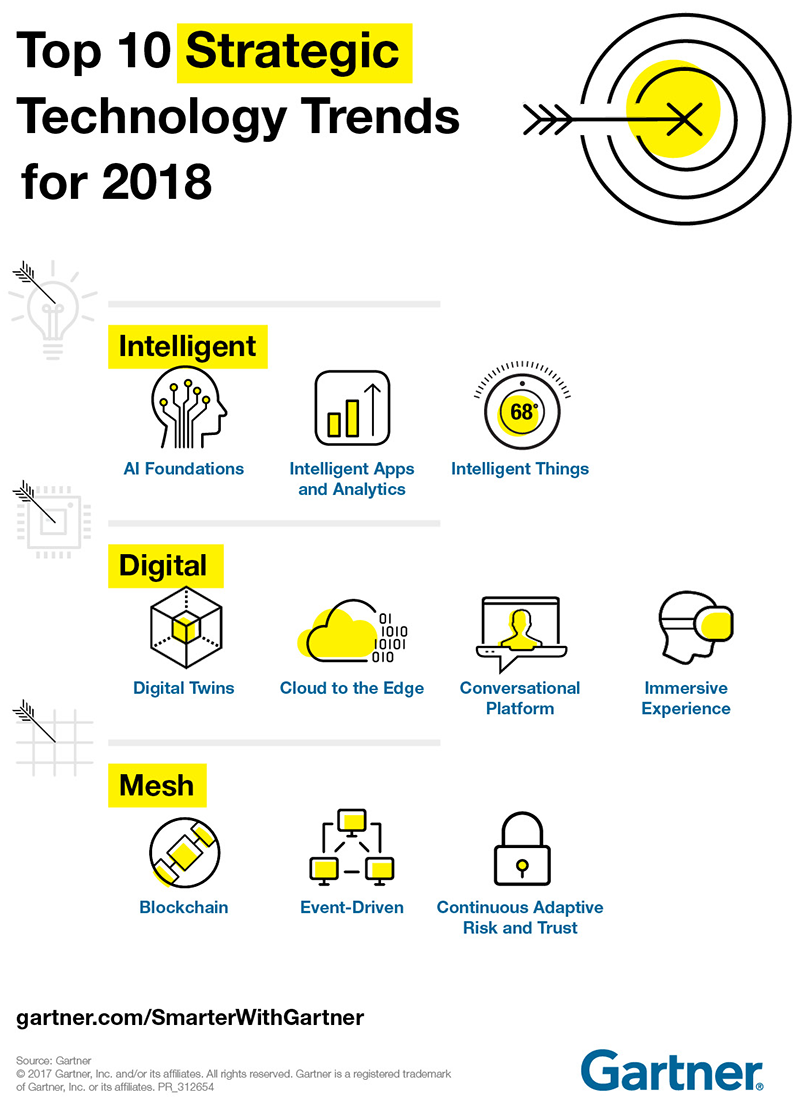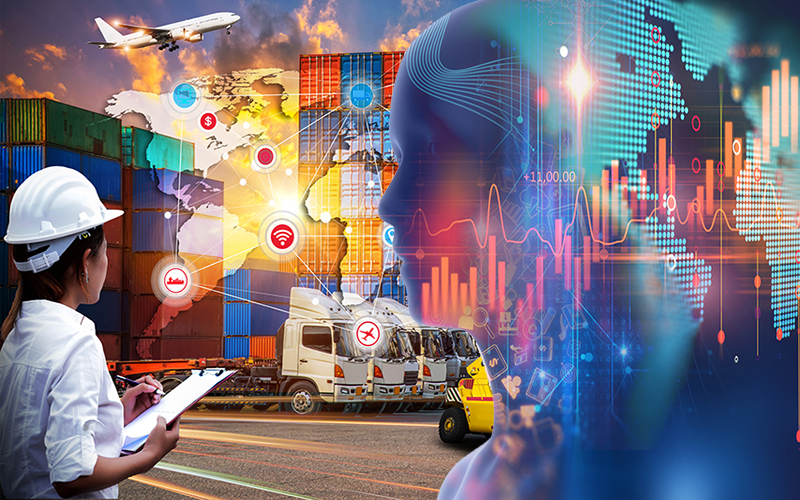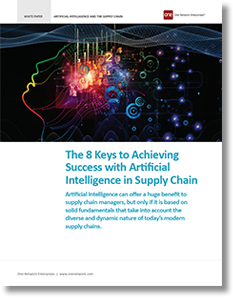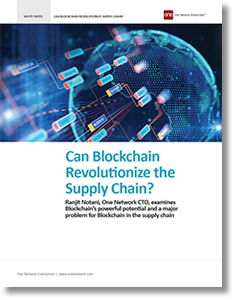Top 10 Strategic Technology Trends for 2018

David Cearley, vice president, and Gartner Fellow details the Gartner Top 10 Strategic Technology Trends 2018 including artificial intelligence, immersive experiences, digital twins, event-thinking and continuous adaptive security.
Artificial intelligence, immersive experiences, digital twins, event-thinking and continuous adaptive security create a foundation for the next generation of digital business models and ecosystems.
How do designers make cars safer?
They treat them like a school of fish.
Safe Swarm, recently unveiled by Honda, uses vehicle-to-vehicle communication to allow cars to pass information on to other cars in the vicinity.
For example, alerts about an accident miles up the road could be relayed to cars miles back, enabling them to operate collaboratively and intelligently to avoid accidents and mitigate traffic.
The evolution of intelligent things, such as collective thinking car swarms, is one of 10 strategic trends with broad industry impact and significant potential for disruption.
“The continuing digital business evolution exploits new digital models to align more closely the physical and digital worlds for employees, partners and customers,” says David Cearley, vice president and Gartner Fellow, at the Gartner 2017 Symposium/ITxpo in Orlando, Florida.
“Technology will be embedded in everything in the digital business of the future.”
The Intelligent Digital Mesh
Gartner calls the entwining of people, devices, content, and services the intelligent digital mesh. It’s enabled by digital models, business platforms and a rich, intelligent set of services to support digital business.
Intelligent: How Artificial intelligence is seeping into virtually every technology and with a defined, well-scoped focus can allow more dynamic, flexible and potentially autonomous systems.
Digital: Blending the virtual and real worlds to create an immersive digitally enhanced and connected environment.
Mesh: The connections between an expanding set of people, business, devices, content, and services to deliver digital outcomes.
Intelligent
Trend No. 1: AI Foundation
The ability to use Artificial intelligence (AI) to enhance decision making, reinvent business models and ecosystems, and remake the customer experience will drive the payoff for digital initiatives through 2025.
Given the steady increase in inquiry calls, it’s clear that interest is growing. A recent Gartner survey showed that 59% of organizations are still gathering information to build their AI strategies, while the remainder has already made progress in piloting or adopting AI solutions.
Although using AI correctly will result in a big digital business payoff, the promise (and pitfalls) of general AI where systems magically perform any intellectual task that a human can do and dynamically learn much as humans do is speculative at best.
Narrow AI, consisting of highly scoped machine-learning solutions that target a specific task (such as understanding language or driving a vehicle in a controlled environment) with algorithms chosen that are optimized for that task, is where the action is today. “Enterprises should focus on business results enabled by applications that exploit narrow AI technologies and leave general AI to the researchers and science fiction writers,” says Cearley.
Trend No. 2: Intelligent Apps and Analytics
Over the next few years every app, application, and service will incorporate AI at some level. AI will run unobtrusively in the background of many familiar application categories while giving rise to entirely new ones.
AI has become the next major battleground in a wide range of software and service markets, including aspects of Enterprise Resource Planning. “Challenge your packaged software and service providers to outline how they’ll be using AI to add business value in new versions in the form of advanced analytics, intelligent processes, and advanced user experiences,” notes Cearley.
Intelligent apps also create a new intelligent intermediary layer between people and systems and have the potential to transform the nature of work and the structure of the workplace, as seen in virtual customer assistants and enterprise advisors and assistants.
“Explore intelligent apps as a way of augmenting human activity, and not simply as a way of replacing people,” says Cearley. Augmented analytics is a particularly strategic growing area that uses machine learning for automating data preparation, insight discovery and insight sharing for a broad range of business users, operational workers, and citizen data scientists.
“Challenge your packaged software and service providers to outline how they’ll be using AI to add business value in new versions in the form of advanced analytics, intelligent processes, and advanced user experiences”
Trend No. 3: Intelligent Things
Intelligent things use AI and machine learning to interact in a more intelligent way with people and surroundings. Some intelligent things wouldn’t exist without AI, but others are existing things (i.e., a camera) that AI makes intelligent (i.e., a smart camera.) These things operate semi-autonomously or autonomously in an unsupervised environment for a set amount of time to complete a particular task.
Examples include a self-directing vacuum or autonomous farming vehicle. As the technology develops, AI and machine learning will increasingly appear in a variety of objects ranging from smart healthcare equipment to autonomous harvesting robots for farms.
As intelligent things proliferate, expect a shift from stand-alone intelligent things to a swarm of collaborative intelligent things. In this model, multiple devices will work together, either independently or with human input. The leading edge of this area is being used by the military, which is studying the use of drone swarms to attack or defend military targets. It’s evident in the consumer world in the opening example showcased at CES, the consumer electronics event.
Digital
Trend No. 4: Digital Twins
A digital twin is a digital representation of a real-world entity or system. In the context of the Internet of Things (IoT), digital twins are linked to real-world objects and offer information on the state of the counterparts, respond to changes, improve operations and add value. With an estimated 21 billion connected sensors and endpoints by 2020, digital twins will exist for billions of things in the near future. Potentially billions of dollars of savings in maintenance repair and operation (MRO) and optimized IoT asset performance are on the table, says Cearley.
In the short term, digital twins offer help with asset management, but will eventually offer value in operational efficiency and insights into how products are used and how they can be improved.
Outside of the IoT, there is a growing potential to link digital twins to entities that are not simply “things.” “Over time, digital representations of virtually every aspect of our world will be connected dynamically with their real-world counterparts and with one another and infused with AI-based capabilities to enable advanced simulation, operation, and analysis,” says Cearley. “City planners, digital marketers, healthcare professionals and industrial planners will all benefit from this long-term shift to the integrated digital twin world.” For example, future models of humans could offer biometric and medical data, and digital twins for entire cities will allow for advanced simulations.
Learning Your ABCs in the Future: Reading, Writing, Coding and AI
In the future, coding could be considered as basic and necessary a skill as reading. That’s according to AI pioneer and Coursera co-founder Andrew Ng.
“The old model of education where you go to college for four years and you coast for the next 40, it just doesn’t work in today’s world where knowledge decays so rapidly and you need to keep learning new things.”
Ng sees a future where people running mom and pop shops will be able to program their store displays and AI will be a seamless part of society.
“I think that we will build an AI-positive society that will deliver much better education, healthcare, transportation,” he told Marketplace Tech.
Trend No. 5: Cloud to the Edge
Edge computing describes a computing topology in which information processing and content collection and delivery are placed closer to the sources of this information. Connectivity and latency challenges, bandwidth constraints and greater functionality embedded at the edge favors distributed models. Enterprises should begin using edge design patterns in their infrastructure architectures - particularly for those with significant IoT elements. A good starting point could be using colocation and edge-specific networking capabilities.
While it’s common to assume that cloud and edge computing are competing approaches, it’s a fundamental misunderstanding of the concepts. Edge computing speaks to a computing topology that places content, computing, and processing closer to the user/things or “edge” of the networking. Cloud is a system where technology services are delivered using internet technologies, but it does not dictate centralized or decentralized service delivering services. When implemented together, the cloud is used to create the service-oriented model and edge computing offers a delivery style that allows for executions of disconnected aspects of cloud service.
Trend No. 6: Conversational Platforms
Conversational platforms will drive a paradigm shift in which the burden of translating intent shifts from user to computer. These systems are capable of simple answers (How’s the weather?) or more complicated interactions (book a reservation at the Italian restaurant on Parker Ave.) These platforms will continue to evolve to even more complex actions, such as collecting oral testimony from crime witnesses and acting on that information by creating a sketch of the suspect’s face based on the testimony.
The challenge that conversational platforms face is that users must communicate in a very structured way, and this is often a frustrating experience. A primary differentiator among conversational platforms will be the robustness of their conversational models and the API and event models used to access, invoke and orchestrate third-party services to deliver complex outcomes.
Trend No. 7: Immersive Experience
Augmented reality (AR), virtual reality (VR) and mixed reality are changing the way that people perceive and interact with the digital world. Combined with conversational platforms, a fundamental shift in the user experience to an invisible and immersive experience will emerge. Application vendors, system software vendors and development platform vendors will all compete to deliver this model.
Over the next five years, the focus will be on mixed reality, which is emerging as the immersive experience of choice, where the user interacts with digital and real-world objects while maintaining a presence in the physical world. Mixed reality exists along a spectrum and includes head-mounted displays (HMD) for AR or VR, as well as smartphone and tablet-based AR. Given the ubiquity of mobile devices, Apple’s release of ARkit and iPhone X, Google’s Tango and ARCore, and the availability of cross-platform AR software development kits such as Wikitude, we expect the battles for smartphone-based AR and MR to heat up in 2018.
Mesh
Trend No. 8: Blockchain
Blockchain is a shared, distributed, decentralized and tokenized ledger that removes business friction by being independent of individual applications or participants. It allows untrusted parties to exchange commercial transactions. The technology holds the promise to change industries, and although the conversation often surrounds financial opportunities, blockchain has many potential applications in government, healthcare, content distribution, supply chain and more. However, many blockchain technologies are immature and unproven and are largely unregulated.
A practical approach to blockchain demands a clear understanding of the business opportunity, the capabilities, and limitations of the blockchain, a trust architecture and the necessary implementation skills. Before embarking on a distributed-ledger project, ensure your team has the cryptographic skills to understand what is and isn’t possible. Identify the integration points with existing infrastructures, and monitor the platform evolution and maturation. Use extreme caution when interacting with vendors, and ensure you are clearly identifying how the term “blockchain” is being used.
Trend No. 9: Event-Driven
Digital businesses rely on the ability to sense and be ready to exploit new digital business moments. Business events reflect the discovery of notable states or state changes, such as completion of a purchase order. Some business events or combinations of events constitute business moments - a detected situation that calls for some specific business action. The most consequential business moments are those that have implications for multiple parties, such as separate applications, lines of business or partners.
With the advent of AI, the IoT, and other technologies, business events can be detected more quickly and analyzed in greater detail. Enterprises should embrace “event thinking” as part of a digital business strategy. By 2020, event-sourced, real-time situational awareness will be a required characteristic for 80% of digital business solutions, and 80% of new business ecosystems will require support for event processing.
Trend No. 10: Continuous Adaptive Risk and Trust
Digital business creates a complex, evolving security environment. The use of increasingly sophisticated tools increases the threat potential. Continuous adaptive risk and trust assessment (CARTA) allows for real-time, risk and trust-based decision making with adaptive responses to security-enabled digital business. Traditional security techniques using ownership and control rather than trust will not work in the digital world. Infrastructure and perimeter protection won’t ensure accurate detection and can’t protect against behind-the-perimeter insider attacks.
This requires embracing people-centric security and empowering developers to take responsibility for security measures. Integrating security into your DevOps efforts to deliver a continuous “DevSecOps” process and exploring deception technologies (e.g., adaptive honeypots) to catch bad guys that have penetrated your network are two of the new techniques that should be explored to make CARTA a reality.
Source: Gartner
Related Article: 8 Fundamentals for Achieving Artificial Intelligence Success in the Supply Chain
Related White Papers
8 Keys to Achieving Success with Artificial Intelligence in Supply Chain
This white paper looks at the fundamentals that supply chains need in place in order to achieve real results from Artificial Intelligence implementations. Download Now!
Can Blockchain Revolutionize the Supply Chain?
In this white paper Ranjit Notani, One Network CTO examines Blockchain’s powerful potential as well as a major problem and whether and how Blockchains can revolutionize the Supply Chain. Download Now!
The Internet of Things and Your Supply Chain
This white paper offers a quick and clear guide to the Internet of Things (IoT), it explains why this technology is so exciting for supply chain and offers a few examples of how it and related technology can be used to dramatically cut costs. Download Now!
Article Topics
Gartner News & Resources
Gartner foresees sizeable uptake for next-gen humanoid robots Risk Management: Building resilient supply chains in a risky world Ranking the Top 10 Schools to Learn About Supply Chains Gartner Unveils Top Trends in Supply Chain Technology Major Shift Underway in Logistics KPI Reporting E-commerce Logistics: An endless array of challenges Supply Chain Management (SCM) applications keep the supply chain humming More GartnerLatest in Technology
Spotlight Startup: Cart.com Walmart and Swisslog Expand Partnership with New Texas Facility Taking Stock of Today’s Robotics Market and What the Future Holds Biden Gives Samsung $6.4 Billion For Texas Semiconductor Plants Apple Overtaken as World’s Largest Phone Seller Walmart Unleashes Autonomous Lift Trucks at Four High-Tech DCs Talking Supply Chain: Procurement and the AI revolution More Technology




















